Roy Orbison
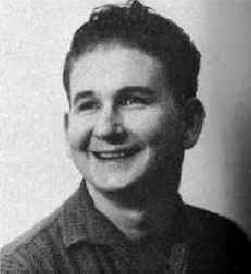
One of the original Sun Records rockabilly artists recording
alongside Elvis Presley, Carl Perkins, and Jerry Lee Lewis, Roy
Orbison went on to become one of the most distinctive singers in
popular music. Wearing trademark sunglasses, black leather
jacket, and slicked back black pompadour, and with a twangy
guitar and quavering belcanto tenor, Orbison scored a number of
hits.
"I think the greatest voice in the world
is Roy Orbison"
Elvis Presley

Orbie and Nadine Orbison
Roy Kelton Orbison was born in Vernon, Texas, on
April 23, 1936. His parents Orbie Lee and Nadine gave him a
guitar for his sixth birthday. He learned to play guitar at
age six from his father and an uncle. Orbie was an auto mechanic
in Vernon, but moved the family to Fort Worth so he could find
work in the defense plants. Orbie ended up on the assembly line
for the B-24 bomber, the Liberator.
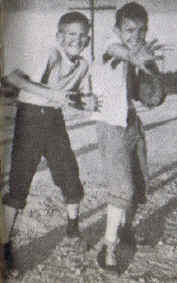
1948 With friend Orbie Lee Harris
Biographer Ellis Amburn portrayed him as a social
outcast from an early age. Orbison dyed his hair black and wore
sun glasses to alter his homely looks. Orbison affected an
egotistical attitude to mask his feelings of inadequacy.
An outbreak of polio in Fort Worth during the war
caused his parents to send him back to Vernon. After V-J Day they
moved back to Vernon as well, soon moving to the West Texas town
of Wink, an oil boom town close to the Mexican border. Orbie
worked for Olson Drilling, across the state line in Jal, New
Mexico.
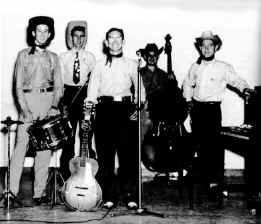
The Wink Westerners
Left to Right: Billy Pat Ellis, James Morrow, Roy Orbison,
Charles Evans and Richard West.
Like many other early rockers, Orbison came from
country music to rock. His father played Jimmy Rogers songs on
the guitar and his uncle played the blues. His talent was
never in doubt: He had his own radio shows from the age of
eight and when he was ten he had played his first paying job - a
medicine show, where he sang the Cajun novelty "Jole
Blon." His first appearance before an audience didn't come
until he was eleven, and then it was as a student at Wink Public
School. When Orbison turned thirteen he formed his first band,
the Wink Westerners in 1952. After the Wink Westerners won a
talent contest organized by Pioneer Furniture company in Midland,
Pioneer sponsored a weekly television show for them on KMID-TV.
The Westerners consisted of Charles Evans on
stand up Bass, Billy Par Ellis on drums, Richard West on piano
and James Morrow on electric mandolin. In 1951, at the age of
fifteen, Orbison and the band began appearing on radio broadcasts
from nearby Kermit. Mr. Limpscombe, superintendent at Wink High
School was running for a position with the district Lions Club
and offered the Westerners $200 to be the opening act when he was
asked to speak. This led to Orbison's trip to Chicago at
the age of sixteen to appear at the National Lions Club
Convention.
The character of the Westerners can be judged by
their name and the Roy Rogers bandanas they were around their
necks. They played Lefty Frizell, Slim Whitman, Webb Pierce. They
also played a lot of Glenn Miller-style songs like
"Stardust" and "Moonlight Serenade," which
they adapted for their string instruments.
In 1954 high school yearbook Orbison spelled out
his ambitions:
To lead a western band
Is his after school wish
And of course to marry
A beautiful
dish.
By the time he graduated from high school, he was
appearing daily on KOSA.
After graduation, Orbison wanted to study geology
in college, but his family didn't have the tuition money.
So he worked in the oil fields near Wink for the El Paso Gas
Company while playing music at night. Later he went to college at
North Texas State in Denton near Fort Worth, transferring to
Odessa Junior College for his second year. Orbison studied
geology, preparing to follow his father in the oil fields if all
else failed
While at North Texas State, Orbison visited the Big
D Jamboree in Dallas and it was there on Apr 16, 1955 that
he saw Elvis Presley for the first time. It was also at this time
where his college buddy at North Texas State, the newly famous
Pat Boone, urged him to experiment with more pop-oriented
songwriting.
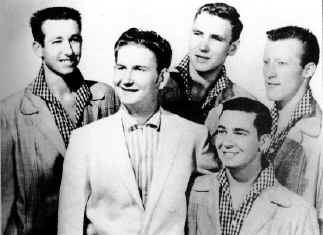
The Teen Kings
From left to right - Billy Par Ellis, Roy Orbison, James
Morrow,
Johnny Wilson and Jack Kennelly
In Odessa Orbison roomed with James Morrow, Jack
Kennelly, and Billy Pat Ellis, who re-cast themselves as the Teen
Kings. The Teen Kings were joined by Johnny "Peanuts"
Wilson on the rhythm guitar, and with this lineup they got
another television show on KOSA, sponsored by the local Pontiac
dealer. In 1955 Johnny Cash appeared on the show and implanted
the idea of recording for Sun.
Orbison acquired the song "Ooby Dooby,"
from Wade Moore and Dick Penner, who had written it in fifteen
minutes on the flat roof of a fraternity house at North Texas
State. In the last half of 1955, Orbison decided to go to Clovis,
New Mexico to record it as a single on Norman Petty's Je-Wel
label. However, Sid King recalls being given a copy
credited to the Wink Westerners by Orbison in January, 1955.
Orbison's group had been playing Ooby Dooby in a modified Texas
swing style for nearly a year and it appears the first version
was probably recorded near Wink while he was at home during the
Christmas holidays.
With help from Orbison's broadcast exposure,
sales were going well around North Texas State. So Petty
approached Columbia in search of a recording contract. Mitch
Miller, who thought rock and roll was just a passing fad, wasn't
interested.
Columbia didn't care for Orbison, but gave it to
one of their contract artist, Sid King who recorded "Ooby
Dooby" on March 5, 1956. A day earlier, Orbison had
re-recorded the song at Norman Petty's studio in Clovis, New
Mexico. The session yielded essential rockabilly, such as
"Domino." In the Petty sessions the Teen Kings sang
backup vocals similar to those popularized by R&B groups.
Orbison's version of "Ooby Dooby" from
the Petty sessions was quickly released on Jean Oliver and Weldon
Roger's Je-Wel Records. The Teen Kings had met Jean, who played
accordion and sang, and her boyfriend Weldon Rogers, at some of
the Friday night jamborees that they played in West Texas.
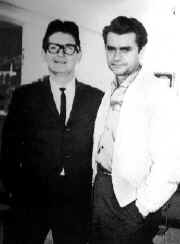
With Sam Phillps
Orbison had approached Sam Phillips at
Sun Records at Johnny Cash's suggestion, but Phillips had
turned him down. However, Orbison had a stronger ally in Cecil
"Pop" Holifield who had record shops in Midland and
Odessa and had booked Elvis Presley into the area. Holifield
played the Je-Wel record over the phone to Phillips, who heard
something unique in Orbison's voice and asked him to send a copy.
Sensing that "Ooby Dooby" might break
like "Blue Suede Shoes,' Phillips moved quickly and brought
the Teen Kings to Sun in late March or early April 1956 to
re-record the song.
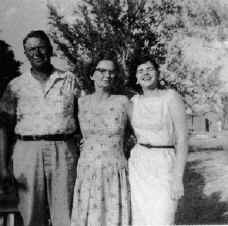
Orbie Lee, Nadine and
Claudette
|
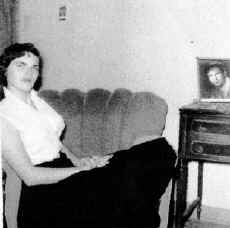
Claudette 1956
|
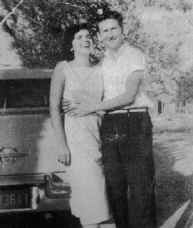
Roy and Claudette, 1956
|
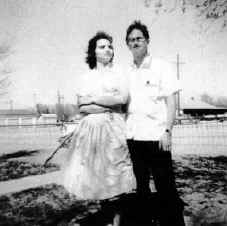
Roy and Claudette circa 1957
|
After the session the Teen Kings returned to West
Texas and heard nothing until Phillips called in early May and
told them the record was breaking in Memphis and other markets.
With his career now launched, Orbison proposed marriage to
Claudette Frady, a fourteen year old brunette from Odessa. They
were married before the end of 1956.
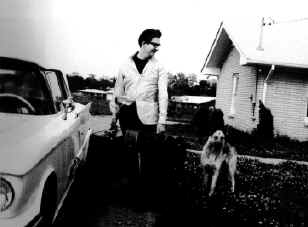
Going on tour
"Ooby Dooby" led to appearances on the Big
D Jamboree and the Ed Sullivan's television (June 1956).
Starting in July and continuing until 1958 the Teen Kings were
placed with and than began touring as part of a package headlined
by Johnny Cash and Carl Perkins."Ooby Dooby" eventually
reached number 59 on Billboard's Hot 100 and sold
roughly 20,000 copies. It would be the biggest hit Orbison had
for four years.
Orbison quickly developed a fascination for
studio work. He worked sessions at Sun for other artists and
performed on the commercials and radio spots. He also started to
write prolifically.
Like Carl Perkin's, Orbison was slow to find a
follow up to his first hit. He recorded "Rockhouse"
that was released in 1956, but it was already behind the times.
Orbison's third single was "Sweet and Easy
To Love" backed with "Devil Doll" in December. It
was during rehearsals for "Devil Doll" and "Sweet
and Easy" that Orbison split from the Teen Kings. Orbison
completed the session with Sun house musicians.
Attempting to revived Orbison's sales, Sun's new
musical director Bill Justis, gave him one of his first tries at
writing rock and roll, "Chicken Hearted," a novelty
song. Released in December 1957, it was Orbison's last on Sun as
a contracted artist.
By this time Orbison, never really comfortable
with rockabilly, was disillusioned with the way Phillips was
handling his career. After "Chicken Hearted" flopped,
Orbison returned to Texas with his new bride, Claudette Frady,
from Odessa.
Orbison knew that his talents were being
misdirected at Sun, and events to come would prove it. After his
return to Texas he began to question if he wanted to continue to
be a performer.
As a writer, Orbison had a fleeting hit for
Warren Smith with "So Long I'm Gone." He did even
better when Jerry Lee Lewis revamped "Go! Go! Go!" as
"Down the Line" the b side of
"Breathless," Johnny Cash recorded "You Tell
Me."
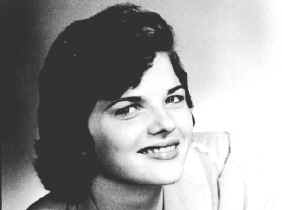
Claudette circa 1957
But it was the success of "Claudette,"
named for his wife, which went to the top on the flip side of the
Everly Brothers' "All I Have to Do Is Dream," that made
Orbison seriously consider writing. Orbison brought out his Sun
contract by signing over all his copyrights (except
"Claudette") and affiliated himself with the Everly's
music publisher, Acuff-Rose.
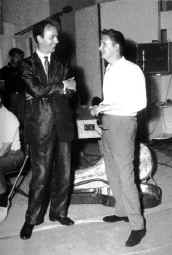
Fred Foster and Roy Orbison
Orbison during his last RCA session had a conversation with
the session bassist Bob Moore, who was buying part of a small
Washington, D.C. based Monument Records. Upon learning that RCA
wasn't going to renew Orbison's contract, Moore went to
Monument's owner Fred Foster who promptly sign him.
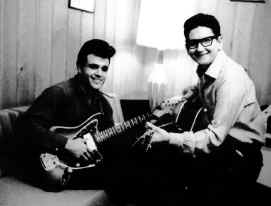
With songwriting partner Joe Melson
Orbison went back to Texas where he began writing with Joe
Melson, who led a local group called the Cavaliers in Midland.
After a few false starts, Orbison and Melson came up with a song
called "Uptown," which sold better than any Orbison
record since "Ooby Dooby," peaking halfway up
Billboard's Hot 100.
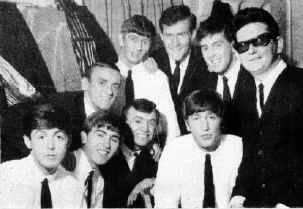
British tour with the Beatles and Gerry
and the Pacemakers
Orbison's first peak period was from 1961 to 1964. During this
time he moved between snarling blues rock and his mainstay, the
romantic ballad with crescendoing falsetto and strings. With his
twangy guitar and belcanto tenor, Orbison had a number of hits
that include among them: "Only the Lonely' (#2 1960),
"Running Scared" (31, 1961), "Crying" (#2,
1961), "Dream Baby" (#4, 1962), "In Dreams"
(#7, 1963) and "Oh, Pretty Woman" (#1, 1964). Orbison
co-wrote almost all his hits and often produced them as well.
Successful in the U.S, Orbison was also a smash in Britain where
in 1963 he toured with the Beatles and Gerry and the Pacemakers.
Heartbreak, a common theme in Orbison's music, shadowed his
life as well. His marriage to Claudette was sweet and sour. He
was away from home for long stretches at a time, she was young
reportedly having an affair. They were divorced in November, 1964
only to remarry the following August. While touring in
England in March 1966 he was nearly killed in a motorcycle
accident. He broke an ankle and performed the rest of the tour
seated on a stool Three months later in 1966, he was riding
motorcycles with his wife, Claudette, whose name was the title of
a tune he wrote in 1955 and the Everly Brothers recorded in
1958,.when a truck driver pulled out in front of her. She died an
hour later at the age of twenty-five.
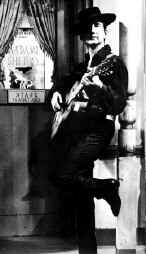
Picture fom The
Fastest Guitar Alive
Following his wife's death in 1966, Orbison's career went on
hold. However, he did appear in the 1967 film The Fastest
Guitar Alive.
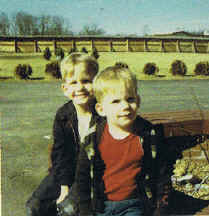
L to R: Roy DeWayne and Anthony King,
spring 1968
In 1968, Roy was on tour in England when he learned of a
second tragedy. Two of their three sons, Roy Dewayne and Anthony
King, had died in a fire at their Nashville home.
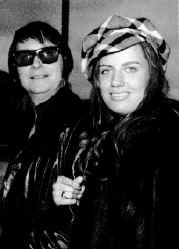
Roy and Barbara Orbison
In 1969, he re-married German born Barbara Wellnoener-Jacobs,
a woman he met while on tour of Britain. A year later they moved
to Dusseldorf and in October 1970, they had a son.
Following his wife's death in 1966, Orbison's career went on
hold. Orbison's popularity remained strong in Britain where he
had appeared at London's Talk of the Town club even as his
popularity in the U.S. was ebbing.
Refusing to join rock 'n' roll revival shows and Orbison
seldom toured in the United States after the late '60s.
After steady work through the '70s, he recorded albums for
Mercury, Monument, and Electra in 1975, 1977, and 1979
respectively, he returned to American touring and saw Linda
Ronstadt score a Top 10 pop and country hit with "Blue
Bayou."
He spent five years without a recording contract. In January
1978, years of cigarette smoking and Southern fried cooking
caught up with him, and he underwent heart bypass surgery at St.
Thomas Hospital near Nashville.
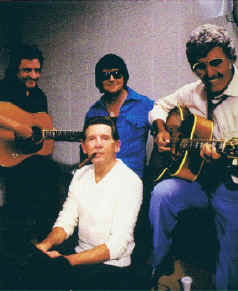
Class of 55
L to R: Johnny Cash, Roy Orbison, Carl
Perkins
Front: Jerry Lee Lewis
Orbison opened the new decade as the opening act on the
Eagles' 1980 tour and a Grammy winning duet with Emmylou Harris
"That Lovin' Feeling' Again on the Roadie
soundtrack. A 1981 comeback show in New York City was both a
commercial and critical success.That same year Don McClean had a
Top 10 hit with "Crying." In 1982 "Oh,
Pretty Woman" was a hit for Van Halen and would later be
revived again as the title theme song of the 1990 hit film Pretty
Woman. In 1986 Orbison rejoined Sun Records alumni Johnny
Cash, Carl Perkins, and Jerry Lee Lewis for Class of '55.
However, Orbison's comeback really began when director David
Lynch used "In Dreams" in a startling scene in his film
Blue Velvet. In 1987 In Dreams: The Greatest Hits, which
presented newly recorded versions of Orbison's was released, and
the taping of an all star tribute show "A Black and White
Night." Taped in Los Angeles' Coconut Grove the tribute
starred Orbison, with backing by Bruce Springsteen, Elvis
Costello, Bonnie Raitt, k.d. lang, Jackson Browne, Jennifer
Warnes, Tom Waits, and J.D. Souther.
Over the years, Orbison came to realize that he had been a
victim of questionable accounting practices by record companies
and the publishers of his song. Being a nice guy, and as long as
he was making money he decided to not rock the boat. In the lean
times of 1982, after hearing Elvis Presley had been owed money,
but was never paid, Orbison decided to do something about it. He
sued Acuff-Rose publishers for $50 million in back royalties.
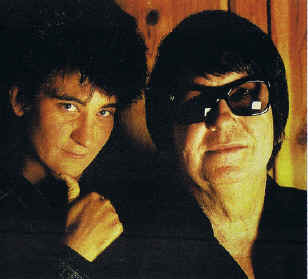
k.d. lang and Roy Orbison
|

The Traveling Wilburys
Back L to R: Jeff Lynne, Bob Dylan, George Harrison
Front L to R: Tom Petty, Roy Orbison
|
In 1987 Orbison's duet remake of Crying" with k.d.lang
hit #42 on the country charts. A chance meeting with Bob Dylan,
George Harrison, Tom Petty, and Jeff Lynne led to the formation
of the extremely successful Traveling Wilburys. At the same time
Orbison was completing work on his next solo album Mystery Girl,
which included the hit Orbison-Lynne-Petty composition "You
Got It" (#9, 1989), which became Orbison's first Top Twenty
hit in 25 years.
Orbison was on the brink of a major solo comeback when on
December 6, 1988 he died suddenly of a heart attack in
Madison, Tennessee, at the age of 52. The posthumously released Mystery
Girl (#5, 1989) became the highest charting album of his
career and eventually was certified platinum. Virgin records
later assembled King of Hearts for 1992 release.
Roy Orbison was inducted into the Rock and
Roll Hall of Fame in 1987.





















